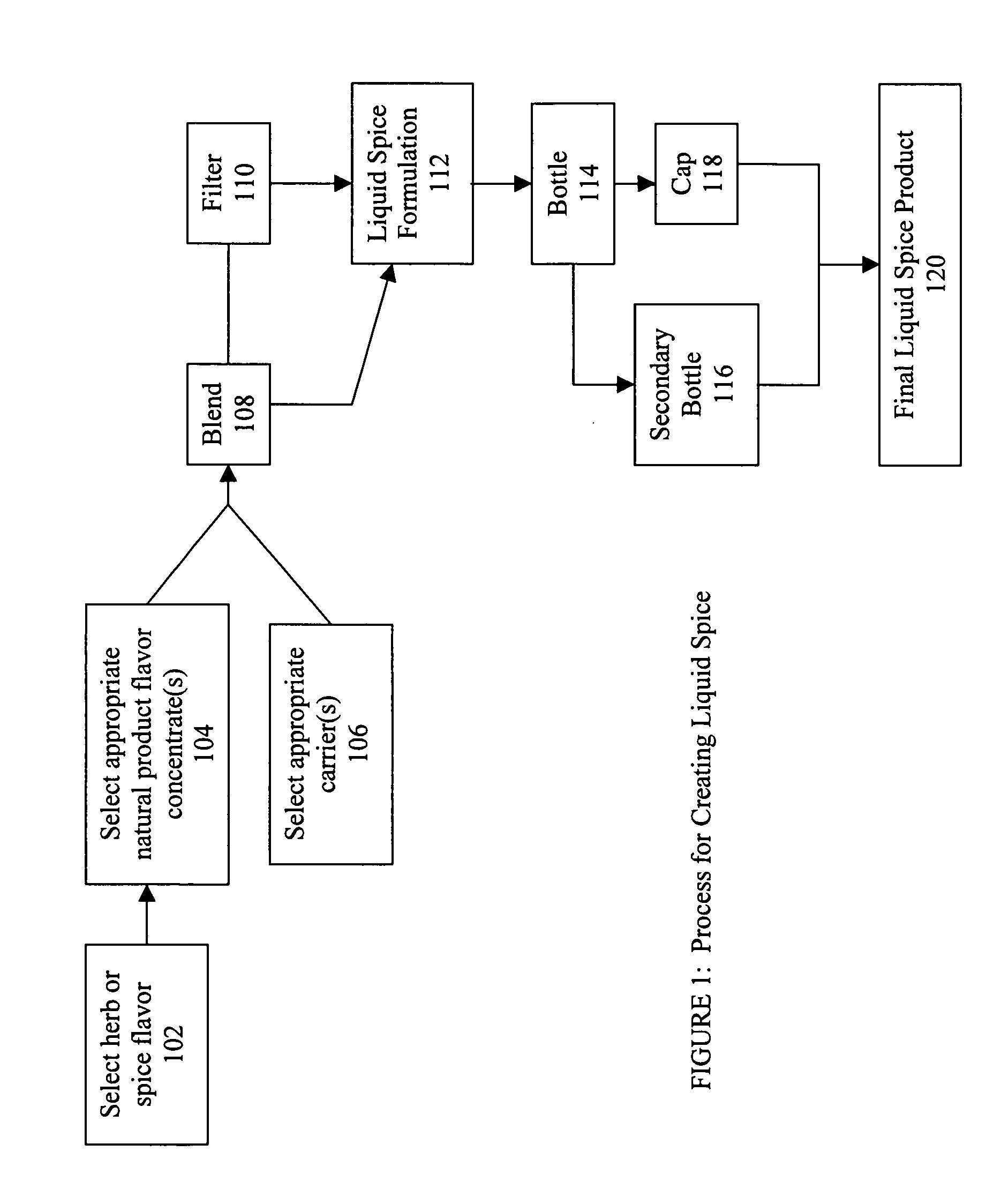Dried spices, however, suffer from a few significant drawbacks to their use.
First, the flavor of a dried spice is not identical to that of the fresh product.
Second, the flavor is not instantly available, often requiring prolonged simmering times to release the flavor.
When cooked together, such as in commercial Indian curry powders, it often occurs that either the cumin ends up burned, or the turmeric remains bitter and undercooked.
Third, the texture of dried spices can be distinctly unpleasant, as in dried rosemary, which is very hard and brittle, and is optimally ground with a
mortar and pestle prior to use.
One further drawback to the use of fresh or dried herbs and spices is the accurate measuring of these foodstuffs.
A typical home chef will use measuring spoons to dispense the herbs or spices, but given the variable sizes and densities of the products, it is difficult to achieve a uniform delivery.
It can also be problematic to fill the measuring spoon: either the spoon must fit into the
jar containing the
herb or spice, or the flavoring must be poured out into the measuring spoon.
In the former case, many spice products come in jars too small to fit the larger measuring spoons, and in applications requiring multiple spices, there is a risk of
contamination when using the same measuring spoon for more than one product.
In the latter case, many spices simply do not pour well, resulting in
spillage, which leads to waste and mess.
In addition to the drawbacks for the home chef in using dried spices, there are other, less generally familiar drawbacks to the use of dried spices.
The presence of these microorganisms can result in potentially serious
contamination, leading to
food poisoning, especially when used in products that are not cooked thoroughly (as in salad dressings, dips, and marinades, to name a few).
Each of these methods has significant drawbacks as discussed below.
Ethylene oxide is extremely flammable and explosive upon mixture with air.
It may cause effects on the eyes, resulting in delayed development of
cataracts.
Long term or repeated
exposure has been shown to cause
cancer in humans and may cause heritable genetic damage in humans.
A residue of ETO remains on the
plant products and must be allowed to dissipate; therefore, the treated herbs and spices are left open to the air for a period of time, which allows the toxic ETO to be released into the air, clearly undesirable given the extreme
toxicity of this compound.
In addition, the exposure of the treated herbs and spices to the air can result in re-
contamination of the foodstuff, especially with mold.
The
fumigation process itself is not always effective.
The density of some spices, or the
physical shape (such as wrinkles in peppercorn or twists in
cinnamon bark), makes
fumigation difficult: the gas cannot penetrate deeply into the dense, ground spice or into the nooks and crannies of the spices.
Because of this limitation, the herbs and spices must be analyzed for microbial content, and if the batch fails the microbial test, the
fumigation process must be repeated.
The result of these reactions can produce a change in flavor of the herb or spice and can also produce a
toxic chemical byproduct, such as
ethylene chlorohydrin, another known
carcinogen.
Finally, the use of ETO as a funigant can result in color and flavor changes in the herb or spice.
The second method of disinfection, nuclear
irradiation, is a technology fraught with controversy and has very little
consumer support.
Much of the public is fearful of all things nuclear, bringing to mind nuclear waste problems, nuclear weapons, and infamous accidents involving
nuclear power plants.
In addition to the inherent risk and problems associated with the
nuclear industry, nuclear
irradiation of food may produce chemical changes in the food, called “radiolytic products” and the newly-produced chemicals may have unknown biological effects, including being toxic or carcinogenic.
There is some evidence that this method is less effective and re-contamination of the spice can occur.
The use of fresh herbs and spices is not normally a practical solution to dispense with the undesirable characteristics of dried herbs and spices.
Fresh herbs and spices have limited
shelf life, are subject to spoilage, and are often unavailable in the quantities that would be necessary
proximate to their point of consumption.
These concentrates have the desired flavor components of the whole herb or spice but are generally incapable of sustaining microbial growth because they are
carbohydrate-free.
These commercial flavor concentrates have generally been available only to commercial food processors because the flavor is so intensely concentrated that their use is only suitable for very large-scale food production.
Essential oils have an even more concentrated flavor than oleoresins, making them even less suitable for home cooking.
In addition, because the processes by which oleoresins and / or essential oils are produced yield a product free of the
carbohydrate fraction of the
natural product, the resulting flavor concentrates are generally incapable of supporting microbial growth.
These products are designed to imitate herb-infused oils, and they are too weakly flavored to be used as replacements for herbs and spices.
 Login to View More
Login to View More  Login to View More
Login to View More 

